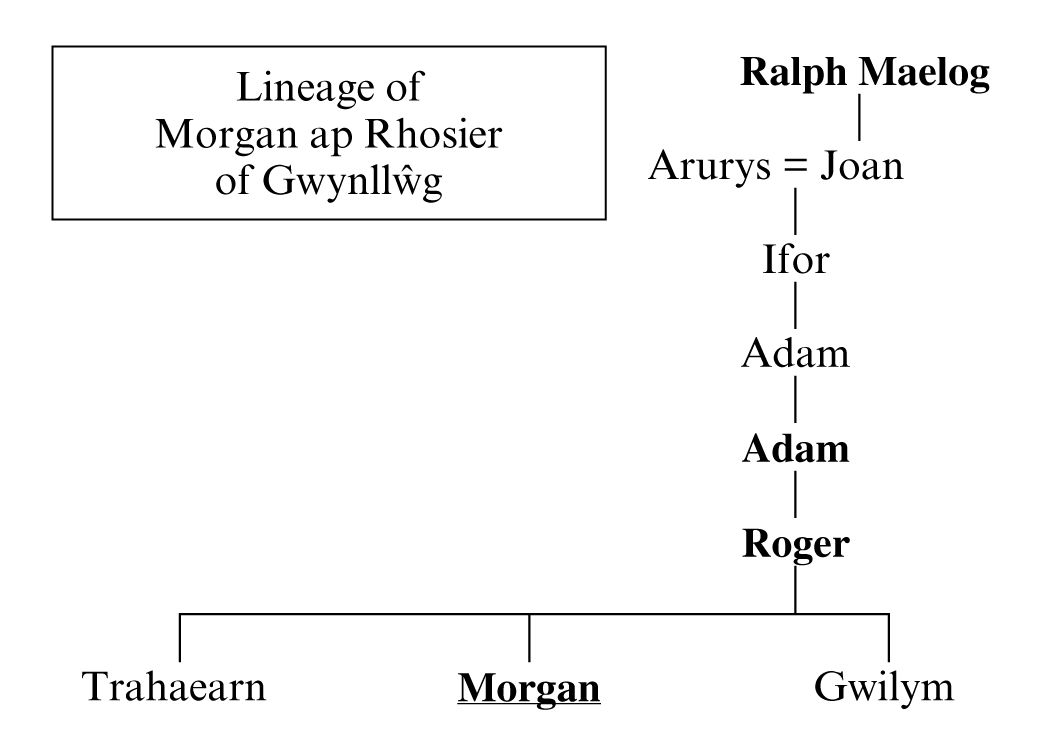Morgan ap Roger was the patron of the bardic debate between Hywel Dafi and Guto’r Glyn (poems 18a and 18). We learn from these two poems that his full patronymic was Morgan ap Roger ab Adam, and that he had a connection with Gwenllwg, with Newport and perhaps with a place called Y Morfa, and claimed descent from the Kemeys family and from a man called Raff.
Lineage
Morgan is not found in the genealogies, but nevertheless it is easy to locate him since the Trahaearn ap Roger ab Adam who is recorded there (WG1 ‘Adam ab Ifor’ 1 and ‘Maelog’) was in all probability his brother (those named in both Guto’s and Hywel Dafi’s poems to Morgan are shown in bold print):

Lineage of Morgan ap Roger of Gwynllŵg
His career
Morgan’s father was Roger ab Adam, bailiff of Wentloog in 1401. Wentloog is the lowland area surrounding Newport, though the Welsh equivalent, Gwynllŵg, seems also to cover a wider area, the whole cantref between the rivers Rhymni and Usk. It is possible that Gwenllwg (a variant of Gwynllŵg) in Hywel’s poem refers to Wentloog only (18a.20n). Morgan’s brother Trahaearn was coroner of Wentloog in 1435–6 and again in 1448–9. He also had a brother called Gwilym who was bailiff in 1409 (Evans 2008: 295–6, 306). Evans (1915: 27n1) notes that Morgan was himself coroner there in 1417. Both he and his brother Trahaearn are listed as free tenants in the assize roll of the lordship of Newport for 1432 (Pugh 1963: 82). Morgan was deputy sheriff of the lordship until 1444 (ibid. 276–7). He is repeatedly named in records from the lordship for the years 1447–8 (ibid. 203–5, 212, 228). On the other hand he is not named in the assize roll of 1476, i.e. in the same context where his name occurs in 1432: it is likely, therefore, that he had died by 1476, not surprisingly given that he was working as coroner of Wentloog as early as 1417. All of this allows us to place Morgan ap Roger roughly in the first half of the fifteenth century.
Morgan’s connection with the Cemais or Kemeys family is not known. Members of his family did marry members of the Kemeys family in the next generation (WG1 ‘Adam ab Ifor’ 1; for the Kemeys family, see WG2 ‘Kemeys’ 1–4 and Griffiths 2008: 261–2). Hywel Cemais succeeded Morgan as deputy sheriff of Newport in 1444 (Pugh 1963: 276–7). For the Ralph from whom Morgan descended, see the genealogy above and 18.44n.
Locality
It is known that Morgan’s father held land in Machen in the region called Cyfoeth Maredudd (Evans 2008: 306). A site known as Castell Meredydd can be seen today on the Ordnance Survey map, a little to the east of the village of Machen (ST 226887). It is not known where Morgan himself lived. Hywel refers to y Morfa (18a.19), which is interpreted with some caution as a place name. It might however refer to the southern part of the lordship of Newport, called in English Wentloog. This area by the sea is very low-lying and parts have been reclaimed from the water. The document reproduced in Pugh 1963: 203–5 shows that Morgan held land at Stow, a place now swallowed up by Newport (cf. Stow Park, ST 303873). He also held land beside a stream called Nant Melyn, had the right to fish in the water of Ebboth (i.e. Ebwy, perhaps the river itself) and he had a wood in a place called Kirkebleyth’ (ibid. 203, 212, 228). In ibid. 205 more places are named, parts of the demesne of Newport, which were in the hands of Morgan ap Roger in the years before 1447/8.
Bibliography
Evans, D.F. (2008), ‘ “Talm o Wentoedd”: The Welsh Language and its Literature, c.1070–c.1530’, R.A. Griffiths et al. (eds.), The Gwent County History, 2: The Age of the Marcher Lords, c.1070–1536 (Cardiff), 280–308
Evans, H.T. (1915), Wales and the Wars of the Roses (Cambridge)
Griffiths, R. (2008), ‘Lordship and Society in the Fifteenth Century’, R.A. Griffiths et al. (eds.), The Gwent County History, 2: The Age of the Marcher Lords (Cardiff), 241–79
Pugh, T.B. (1963), The Marcher Lordships of South Wales 1415–1536: Select Documents (Cardiff)





